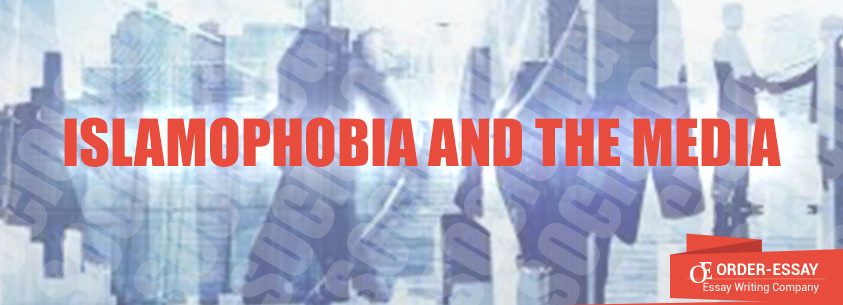
Introduction
Islamophobia refers to prejudices and aversions that are socially reproduced to Muslims and Islam religion as whole. It entails people’s actions and practices, which are often geared towards attacking, excluding or propagating discrimination against other people which are the faithful of Islam or associated with Islam religion. The term Islamophobia became popular in 1997 after the publication of a report by Runnymede Trust, which utterly condemned the negative emotions that people directed at Muslims and Islam religion (Iqbal, 2010). The unfounded hatred, as well as trepidation of people towards Muslims in the ordinary community, had reached alarming proportions as they were associated with radicalism and barbarism that instigated terrorist activities which caused untold tribulations to other people. It became evidently normal that Muslims were the main perpetrators of terror activities. The statistics revealed that people often implicate members of that religion as culpable for the isolated heinous acts around the world. The global seal for the terminology ‘Islamophobia’ is dated back to September 11, 2001, when the suicidal fanatics, all from Muslim community, organized a contrived lethal attack on the United States’ World Trade Centre, New Yolk, as well as on Pentagon in Washington DC (Iqbal, 2010). Since then, the majority of the people in the world have condemned Muslims for all the subsequent terrorist attacks that have occurred in the world. The media in particular has been on the forefront to describe Islam and Muslims as notions associated with the increased insecurity in the world. Current research analyses how the media has propagated the fear for Islam as a religion.
How the Media Manifests Islamophobia
Bleich, (2012) emphasizes that since September 11, 2001 events, the mainstream media in the West began projecting Islam as a violent religion. In addition, Bleich (2012) states that some reports have revealed that according to Islam religion such dreadful activities are justified, since the religion legitimizes vengeful practices. Others, however, refuted such claims as they try to defend the Islam religion claiming that it is free from propagating terrorism. According to some, the mystery remains as to whether the ongoing terror activities have connection with Muslims and the teachings of Islam and whether the repugnant attitude of other people towards Muslims is justified.
Brinson (2011) established that within the media fraternity, Islamophobia refers to the perception or occurrence that a number of media networks portray Islam teachings and Muslims negatively as compared to other religions in the world. Very often the journalists have a tendency of highlighting crimes that orchestrated by Muslim criminal in an undue and disproportionate manner. The media has, therefore, been found to play a significant role in promoting Islamaphobia across the world, thus, polarizing people in perpetuating religious sadism. In America, for instance, the media has adversely been criticized for being the prime perpetrator of Islamophobia. It has been cited that Muslim standpoints are direly underrepresented. At the same time, the media has often depicted negative issues involving Muslims, in particularly as a threat to the Western values and security. The persistent portrayal of Muslims and Islam as irrational, barbaric, sexist and irrational has largely elicited enormous hostility of other religions towards their Muslim counterparts.
According to Brinson, (2011), some of the blatant ways through which the media has negatively portrayed Islam is by use of descriptive clauses, such as Islamic terrorism, Islamic bombs and violent Islam, Muslim brotherhood radical group, among others. Dealing with description of criminals from other religious affiliations has according to Brinson created a deleterious attitude among non-Muslims who tend to believe that every bad thing done in the world is done by Muslims. He added that, there are even worse criminals among the Christian believers who have done worse crimes against humanity without receiving excessive attention of media.
In other scenarios, the British media has also propagated negative stereotypes of Muslims, as well as increasing the anti-Muslim prejudice. In fact, reports have depicted 85% of articles posted in the mainstream newspaper treating Muslims as faithful and a homogenous mass of people who were also deemed as a big threat to the British society (Yang & Self, 2015). But the Muslim representatives have sharply reacted to such insinuation by criticizing Western media for their quick over-reporting of isolated Islamic incidents, while under-reporting incidents done by the much larger number of non-Islamist terrorists, especially the non-Irish white folks. A research conducted in 2012 on different European countries, such as Germany, France and the UK indicated that Muslims across the region usually experience Islamophobia of the highest magnitude in the media as compared to Muslims in other regions of the world (Yang & Self, 2015).
Following the dreadful events of September 11, which were purportedly coordinated and executed by the radical Al-Qaeda, an Islamic terrorist organization, the interest of the media in Islam, as well as the Muslim community, became significant as it was considered a profoundly problematic section of the society. Consequently, immediately after the planes crashed into the World Trade Center’s Twin Towers in New York, Muslim and terrorism became inextricable (Iqbal, 2010). A number of analysts from assorted quarters expressed the feeling that the tragic ordeals of September 11 resulted in appearance of a marked hysterical tone coupled with frantic and ill-informed media reporting. Subsequently, the events of September 11 were followed by a drastic decline in journalistic ethics regarding the discussions and debates on Islamic religion and Muslims.
Through unrestricted discussions in the society and in the media, it is noted that Muslims are often regarded as a monolithic bloc and a closed but united faction of people. More so, their traits are totally dissimilar from another or even more intimidating and largely hostile to an equally closed Western civilization, which entails Christianity, secularism, liberality and democracy. Such descriptive comparison between the Muslims and the Western realms is profoundly contrasting. The contradictory poles resulted in an understanding of relations which are dualistic and which act in disregard to many fine exceptions and distinctions. Regardless of all the statements made, it has been been stated that the risk of Arabs has expansively been overestimated by popular media outlets to an extent that made westerners to perceive Islam as a class of people only in the context of the adversaries of democracy and modernization.
Other contrasting views equated with Islamophobia as openly raised by the media are that Islam is viewed as a monolithic bloc, comprising of people who are static and unresponsive to change. The media still describes Muslims as adamant and fanatics of bygone religious beliefs, which do not necessarily apply in the contemporary society. Similarly, the religion of Islam has been perceived as an inferior culture as compared to the western one. Therefore, its followers try to announce their existence only through barbarism, irrationality and primitivism as exhibited through their violence, aggressiveness, threats, support of terrorism and their persistent engagement in a clash of civilizations.
Several reports show that the media has further looked at Islam as an ideology that is used for political, as well as military advantage. For instance, the Arabian countries which have been associated with funding of terrorist activities and their attempts to manufacture nuclear weapons for purposes of gaining a political advantage over the western powerful countries, have been the subject of ridicule by the media. However, their counter-criticisms of the west are usually rejected out of hand and the media would always decline featuring about them in depth the way it features the negative side of Islam. Media is said to have consistently used hostility towards Islam to justify discriminatory practices towards Muslims’ faith and their execution from the mainstream society. Most non-Muslims have also viewed the hostility as natural and a normal phenomenon.
On the other hand, some media outlets have been making efforts to fight against Islamophobia. The United States government has been severally reproached for having conspired to propagate such stereotypes against the Muslim community. According to Kumar (2010), in 2008 the Fairness and Accuracy in Reporting (FAIR) published a report that outlined how the Islamophobes were determined to spread misinformation, bigotry and fear among the non-Muslims. The report further cited a number of cases where the mainstream authors, journalists and scholars opted to make analyses that make negative traits about Islam essential as an inherent part of the Muslims’ morality. Besides, FAIR established the Forum Against Islamaphobia (FAI) as a special movement designed with the purpose of monitoring unscrupulous coverage in the media together with establishing dialogue with the relevant media organizations for that matter.
As pertains to the September 11 attacks, the Islam Awareness Week, the Islamic Society of Britain and the Best of British Islam Festival were instigated as a measure of improving community relations, as well as raising awareness about the position of Muslims regarding terror activities (Kumar, 2010). In addition, it necessitated the launch of a Muslim TV through which they anticipated to reach out a wider coverage in propagating their anti-terror principles as a way of proving to the world how Islam was committed in their fight against terrorism and how Islamic teachings condemned any form of terror against innocent civilians. It was reported that such actions were among the concerted efforts employed by the Muslim groups in conjunction with the liberal civic groups to antagonize the overstretched syndrome of Islamaphobia. Since then, sanity of a considerable degree has been witnessed in the media, especially after realizing that criminals do not have race, nationality, ethnicity, religion or social class.
Get a Price Quote
Solutions and Conclusion
The manifestation of media on Islamophobia has been become a concern to many nations. A number reports have depicted how various governments condemned the media’s role in propagating Islamophobia. Certain lobbies groups which believe in liberality and sound judgment have also encourage the media to be assessing issues rationally before making conclusions. Distancing Islam from the terror implications, the Muslim leadership has also taken the initiative to admonish the entire society to be aware of the habit of terrorists disguising themselves in the name of the religion to orchestrate terror. The further elucidated that the actions perpetrated by terrorists were typically personal and neither were they done on behalf of the religion nor did they signify any belief in Islam. The Muslim leaders also urged the governments to make firm declarations about the syndrome of Islamophobia to prevent people from negating Muslim citizens and associating them with terrorism. They argued even them could still suffer the severely because of terrorism.
A number of lobby groups such as the International Human rights Watch also added weight behind the sentiments raised by Muslim leaders that criminals do not exclusively belong to a certain religion or state and can disguise themselves in Islam, Christianity or Hindu to accomplish their dirty mission. They further urged the media groups to come to the realization that crimes of high magnitude have in the past been committed by non-Muslims and yet their religions were not accosted. Using the example of serious atrocities that were committed by leaders, such as Adolf Hitler of Germany, Benito Mussolini of Italy, Iddi Amin Dada of Uganda, and the Rwandan genocide of 1994; and whose religious affiliation remained anonymous, the movement sought to distance Islam religion from any links to terror (Steinberg, 2010).
Summarily, the media has largely been advised by the concerned parties; government agencies in charge of information, non-governmental organizations, and other religious groups to seriously consider its position regarding propagation of the syndrome of Islamaphobia. They have ridiculed the media fraternity for going against their professional ethics on media practice to report with biasness against a certain component of the society. They further termed it erroneous for the media to implicate the whole religion in terrorism even without producing any evidence to proof the allegations.











